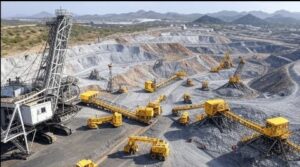Vancouver, B.C. – Prospero Silver Corp. (TSXV: PSL) (“Prospero” or the “Company”) is pleased to announce that it has acquired by staking the 6,000 hectare El Petate project located 30km northwest of the historic Pachuca-Real del Monte mining district. This new project acquisition is part of a systematic exploration program in the Mexican Altiplano and reflects Prospero’s strategy of creating value as a Mexico-focused project generator. El Petate will be added to the Company’s portfolio of 100% owned projects available for joint venture.
El Petate is located on the part of Mexico’s Sierra Madre Oriental fold belt that hosts the Pachuca and Zimapan mining districts. The property exhibits an outcropping set of northwest to east-west trending silica reefs called the Escoba, Apartadero and El Petate trends, all of which lie within an area of 4km x 4.5km and are fully within the claim boundaries.
Prospero completed three rounds of preliminary surface sampling comprising 75 channel and grab samples including grab samples of 105 g/t Ag (#52368) and 140 g/t Ag (#52370) from outcrops of gossan and skeletal quartz. Of special interest is El Petate’s #3 target (Figure 1), which includes several outcrops exposed along a creek for a distance of 50m. Thirteen channel samples obtained along these outcrops returned consistent gold assay values averaging 0.166 g/t Au and 10.4 g/t Ag (Samples #52383 to #52397) A comprehensive table featuring assay results and an accompanying description for each sample is contained later in this release.
Another feature of note is the existence of two historic mines within the claim boundaries. The El Aguila mine was developed for high grade manganese ore and consists of a zone 5m wide with heavy manganese oxides and calcite in the footwall of a syenite dike. Two grab samples from the El Aguila dump assayed at 345 g/t Ag and 595 g/t Ag with significant base metal readings. The Plomosa mine has a mine dump approximately 2,000 tons in size. Two channel samples from the mine workings indicate the presence of elevated base metals (6.86% Pb, and 0.87% Pb).
“We were pleased to be able to identify and stake this project but are surprised that the ground was open given the large size and strong geochemical responses from what is clearly a high level system,” said Tawn Albinson, Prospero’s President and CEO. “It is unusual in Mexico to encounter gossan outcrops at surface with readings exceeding 100 ppm Ag that lack past prospecting. In addition there is a canyon to the east of the Petate East Zone which drops 700m in elevation and this could be a benefit for any future development of the system,” he added.
The Escoba, Apartadero, and El Petate silica reefs feature dominant fine crystalline quartz as stockwork and breccias as well as silicification of the massive limestones of the Doctor Formation. The moderate to strong presence of iron and manganese oxides is associated with the silica invasion creating red iron oxide-stained soils that make the reefs easily visible on Google Earth and in ASTER (Advanced Spaceborne Thermal Emission and Reflection Radiometer) images. The surface expression of the silicification is usually characterized by abundant float and sub-outcrops, which are associated with some cultivated parcels of land due to the pronounced presence of nutrients in the soils.
Structural controls of the reefs have been identified at some locations in outcrop and exhibit a set of predominately northwest oriented faults dipping west which are parallel to the fold axis of the limestones.
Results from the preliminary surface sampling are shown in the following table:
| SAMPLE | Width | Au | Ag | Mn | Pb | Sb | Zn | |||
|---|---|---|---|---|---|---|---|---|---|---|
| Number | Type* | (mts) | ppm | ppm | ppm | ppm | ppm | ppm | Location | Description |
| 52334 | C | 1.20 | 0.122 | 5.5 | 493 | 68600 | 292 | 561 | Plomosa Mine | Limestone with oxides |
| 52335 | C | 1.00 | 0.065 | 3.1 | 860 | 8700 | 972 | 521 | Plomosa Mine | Weathered red suboutcrop |
| 52339 | G | 0.018 | 345.0 | >50000 | 1445 | 984 | 1340 | El Aguila Mine | Dump, calcite with oxides | |
| 52367 | G | 0.047 | 595.0 | >50000 | 2660 | 413 | 1390 | El Aguila Mine | Dump, calcite with oxides | |
| 52340 | G | 3.00 | 0.004 | 30.0 | 24000 | 8 | 13 | 158 | Petate # 1 | Limestone bx with oxides |
| 52341 | G | 0.002 | 9.4 | 9720 | 19 | 10 | 21 | Petate # 1 | Skeletal calcite-quartz | |
| 52407 | G | 0.001 | 7.6 | 12600 | 9 | 4 | 10 | Petate # 1 | Silica float with Mn oxides | |
| 52408 | G | 0.002 | 3.6 | 1295 | 4 | 2 | 6 | Petate # 1 | Amorphous silica-Mnox | |
| 52409 | G | <0.001 | 10.5 | 35100 | 17 | 4 | 27 | Petate # 1 | Silica float with Mnox | |
| 52411 | G | 0.05 | 0.001 | 61.1 | >50000 | 37 | 190 | 1090 | Petate # 1 | Silica-massive Mnox |
| 52412 | G | 0.003 | 3.6 | 3850 | 6 | 2 | 9 | Petate # 1 | Jasper float | |
| 52413 | C | 1.00 | 0.022 | 6.8 | 8150 | 10 | <2 | 18 | Petate # 1 | Red soil in situ(?) |
| 52414 | C | 0.70 | 0.005 | 7.7 | 4390 | 4 | 4 | 14 | Petate # 1 | White banded quartz -Mnox |
| 52415 | G | 0.001 | 16.0 | 40800 | 12 | 5 | 22 | Petate # 1 | Skeletal quartz-oxides | |
| 52342 | G | 0.001 | 38.2 | 7490 | 8 | 14 | 7 | Petate # 2 | Skeletal silica float 20% oxs | |
| 52368 | G | 0.016 | 105.0 | 37700 | 18 | 11 | 65 | Petate # 2 | Gossan of oxides, suboutcrop | |
| 52369 | C | 0.30 | 0.005 | 26.3 | 5270 | 3 | 5 | 11 | Petate # 2 | Skeletal quartz vein-oxides |
| 52370 | G | 0.003 | 140.0 | 6410 | 6 | 18 | 7 | Petate # 2 | Skeletal quartz-oxides | |
| 52398 | G | 0.001 | 1.0 | 384 | <2 | 2 | <2 | Petate # 2 | White silica-oxides | |
| 52399 | G | <0.001 | 0.9 | 1645 | 3 | <2 | 3 | Petate # 2 | White silica float with Mn ox | |
| 52400 | G | 0.001 | 3.7 | 3540 | 5 | 2 | 4 | Petate # 2 | Silica float with oxides | |
| 52401 | G | 0.001 | 30.0 | 8450 | 5 | 8 | 8 | Petate # 2 | Skeletal silica with oxides | |
| 52402 | G | 0.007 | 3.4 | 8210 | 4 | 5 | 30 | Petate # 2 | Limestone-skeletal silica-oxs | |
| 52403 | C | 1.20 | 0.016 | 8.5 | 1320 | 6 | 3 | 12 | Petate # 2 | Red soil abt. Mn oxides |
| 52404 | C | 1.60 | 0.011 | 16.5 | 4750 | 8 | 12 | 15 | Petate # 2 | Skeletal silica with Mnox |
| 52405 | G | 0.70 | 0.012 | 4.7 | 637 | 4 | 4 | 10 | Petate # 2 | Weathered dike (?) outcrop |
| 52406 | G | <0.001 | 0.6 | 1215 | 4 | <2 | 3 | Petate # 2 | Skeletal silica-Mn oxides | |
| 52410 | G | 0.60 | 0.005 | 11.9 | 2690 | 6 | 8 | 11 | Petate # 2 | Silica vein with Mnox |
| 52375 | C | 0.50 | 0.019 | 1.6 | 5880 | 10 | 16 | 29 | Petate # 3 | Gossan of Fe-Mn oxides |
| 52376 | G | 2.00 | 0.002 | <0.2 | 698 | <2 | 38 | 17 | Petate # 3 | Banded calcite vein-oxides |
| 52381 | C | 0.10 | 0.006 | 10.8 | 15750 | 5 | 8 | 16 | Petate # 3 | Skeletal quartz with Mn oxs |
| 52382 | G | 1.10 | 0.167 | 2.8 | 1045 | <2 | 60 | 18 | Petate # 3 | Marble with calcite-oxides |
| 52383 | G | 0.50 | 0.117 | 89.4 | 7640 | 6 | 36 | 14 | Petate # 3 | Fault zone with calcite-oxides |
| 52384 | C | 0.30 | 0.017 | 1.1 | 292 | 2 | 5 | <2 | Petate # 3 | Fault with silica-oxides |
| 52385 | C | 1.00 | 0.152 | 5.2 | 4490 | 6 | 13 | 16 | Petate # 3 | Sacharoidal silica-oxides |
| 52386 | G | 2.00 | 0.062 | 2.9 | 1665 | 2 | 10 | 5 | Petate # 3 | Limestone with calcite-oxs |
| 52387 | C | 1.00 | 0.092 | 7.8 | 2250 | 3 | 23 | 10 | Petate # 3 | Gray silica with abundant oxs |
| 52388 | C | 0.70 | 0.204 | 6.9 | 2770 | 9 | 28 | 28 | Petate # 3 | Skeletal silica with abt. oxs |
| 52389 | C | 0.60 | 0.49 | 8.9 | 7810 | 10 | 16 | 28 | Petate # 3 | Gossan with heavy Mn-Fe oxs |
| 52390 | C | 1.40 | 0.366 | 17.1 | 3570 | 6 | 36 | 27 | Petate # 3 | Skeletal silica with 25% oxs |
| 52393 | C | 2.10 | 0.148 | 18.7 | 5760 | 9 | 33 | 15 | Petate # 3 | Fault with skeletal silica-oxs |
| 52394 | C | 1.60 | 0.087 | 9.3 | 4400 | 7 | 32 | 18 | Petate # 3 | Gossan with silica-30% oxides |
| 52395 | C | 0.35 | 0.288 | 5.3 | 5030 | 9 | 22 | 16 | Petate # 3 | Gossan, massive Fe-Mn oxs |
| 52396 | C | 1.30 | 0.057 | 2.9 | 3490 | 5 | 7 | 8 | Petate # 3 | Limestone, porous, 15% oxs |
| 52397 | C | 1.20 | 0.164 | 6.6 | 3830 | 6 | 37 | 18 | Petate # 3 | Limestone, silicified, 20% oxs |
| 52377 | G | 0.60 | 0.008 | <0.2 | 363 | 5 | 3 | 4 | Petate # 4 | Skeletal quartz-oxides |
| 52378 | G | 0.001 | 2.4 | 464 | 5 | 8 | 2 | Petate # 4 | Skeletal quartz-oxides | |
| 52379 | G | <0.001 | 0.7 | 158 | 2 | <2 | <2 | Petate # 4 | Skeletal quartz bx float | |
| 52380 | G | 0.01 | 3.6 | 241 | <2 | 5 | <2 | Petate # 4 | Jasper with oxides | |
| 52416 | G | 1.50 | 0.001 | 1.3 | 1880 | 16 | 2 | 19 | Petate West | Silicified limestone |
| 52417 | G | 0.60 | 0.002 | 0.4 | 203 | 2 | 2 | 21 | Petate West | Silicified limestone |
| 52418 | G | 0.022 | 2.2 | 260 | 11 | 53 | 81 | Petate West | Jasper float with pyrite-oxs | |
| 52419 | G | 0.038 | 1.0 | 23 | 22 | 95 | 8 | Petate West | Silicified limestone float | |
| 52337 | G | 3.00 | 0.024 | 0.3 | 286 | 116 | 52 | 51 | Petate West | Limestone with oxides |
| 52338 | G | 0.009 | 0.2 | 61 | 26 | 55 | 11 | Petate West | Jasper Float | |
| 52343 | G | 0.041 | 1.3 | 626 | 7 | 16 | 11 | Petate West | Skeletal silica with oxides | |
| 52344 | G | 1.50 | 0.001 | 1.0 | 212 | 3 | 18 | 3 | Petate West | Skeletal silica reef |
| 52345 | G | 0.006 | 0.2 | 67 | 3 | 8 | 3 | Petate West | Silicified boulder with oxs | |
| 52346 | G | 1.00 | 0.013 | 0.5 | 30 | 14 | 36 | 7 | Petate West | Silicified bx reef with oxs |
| 52347 | G | 1.00 | 0.001 | 0.4 | 32 | 235 | 5 | 5 | Petate West | Float of banded silica |
| 52348 | G | 1.00 | 0.117 | 0.4 | 34 | 14 | 38 | 10 | Petate West | Skeletal silica stockwork |
| 52349 | G | 1.00 | 0.005 | 0.2 | 52 | 33 | 25 | 6 | Petate West | Silicified bx with oxides |
| 52350 | G | 2.00 | 0.002 | 0.3 | 22 | 15 | 10 | 6 | Petate West | Silicified bx reef |
| 52361 | G | 0.04 | 0.095 | 1.4 | 28 | 8 | 80 | 5 | Petate West | Silicified fault zone |
| 52362 | G | 0.70 | 0.170 | 1.6 | 26 | 9 | 52 | 6 | Petate West | Silicified fault breccia |
| 52363 | G | 0.251 | 1.6 | 45 | 12 | 49 | 6 | Petate West | Non-silicified host of 52362 | |
| 52364 | G | 0.009 | <0.2 | 21 | 3 | 27 | 5 | Petate West | Silicified bx with oxides | |
| 52365 | G | 0.002 | <0.2 | 47 | 4 | 7 | 4 | Petate West | Float of silica-oxides | |
| 52366 | G | 0.721 | 1.2 | 55 | 4 | 178 | 8 | Petate West | Breccia with calcite-oxides | |
| 52371 | G | 0.10 | 0.010 | 0.8 | 122 | 7 | 26 | 47 | Petate West | Fault with silicified breccia |
| 52371A | C | 0.50 | 0.004 | 6.5 | 379 | 2 | 14 | 3 | Petate West | White banded quartz vein |
Prospero will carry out detailed mapping and sampling surveys in selected areas and complete ASTER image interpretation before defining targets. The extensive presence of petrographically low temperature (<200°C) silicification associated with the geochemically anomalous areas represents high level alteration typical of the upper portions of high temperature carbonate replacement type deposits. Significantly, the elevated readings of Mn, Sb, As, Ba, and Hg, and in particular of manganese oxide occurrences, have long been considered typical of the higher and peripheral portions of carbonate replacement deposits in the Mexican Altiplano, with the historic Santa Eulalia and Mapimí mining districts representing good examples. The elevated precious metal and base metal values at El Petate suggest proximity to the possible top of a higher grade mineralized system. Elevated Ag assays, commonly associated with gossan and skeletal quartz outcrops, and locations that exhibit consistent fractions of ppm Au over widths collectively exceeding tens of meters (e.g. Petate #3 jasperoid) are more than merely anomalous.
Tawn Albinson, M.Sc., President of the Company, is a Qualified Person, as defined in NI 43-101, and is responsible for the technical content of this press release. The samples were analyzed by ALS Chemex, by the following methods, gold by Au-ICP21 with a lower limit of detection of 0.001 ppm; silver (with a lower limit of detection of 0.2 ppm) by multielemental ME-ICP41, and mercury by Hg-CV41.
About Prospero Silver Corp.:
Prospero is a Canadian resource company with the majority of its staff based in Mexico and who work for its wholly owned subsidiary Minera Fumarola, SA de CV (Fumarola). Following a project generator model to de-risk exploration and minimize dilution, the Company has a growing portfolio of high-quality projects and has been successful in finding strong partners.
For further information please contact:
William Murray
Chairman
Tel: (604) 248–0797
or
Peter Murray
Contact Financial
604-689-7422
Forward-Looking Statement Cautions:
This news release contains certain “forward-looking statements” within the meaning of Canadian securities legislation, relating to the closing of a non-brokered Private Placement. Although the Company believes that such statements are reasonable, it can give no assurance that such expectations will prove to be correct. Forward-looking statements are statements that are not historical facts; they are generally, but not always, identified by the words “expects,” “plans,” “anticipates,” “believes,” “intends,” “estimates,” “projects,” “aims,” “potential,” “goal,” “objective,” “prospective,” and similar expressions, or that events or conditions “will,” “would,” “may,” “can,” “could” or “should” occur, or are those statements, which, by their nature, refer to future events. Factors that could cause actual results to differ materially from these forward looking statements include, but are not limited to, variations in the nature, quality and quantity of any mineral deposits that may be located, the Company’s inability to obtain any necessary permits, consents or authorizations required for its planned activities, and the Company’s inability to raise the necessary capital or to be fully able to implement its business strategies. The reader is referred to the Company’s reports, publicly available through the Canadian Securities Administrators’ System for Electronic Document Analysis and Retrieval (SEDAR) at www.sedar.com, including the risk factors discussed in Prospero’s November 27, 2009 prospectus. Except as required by securities laws and the policies of the TSX Venture Exchange, Prospero disclaims any intention or obligation to update or revise any forward-looking statement, whether as a result of new information, future events or otherwise.
Neither the TSX Venture Exchange nor its Regulation Services Provider (as that term is defined in the policies of the TSX Venture Exchange) accepts responsibility for the adequacy or accuracy of this release.

















